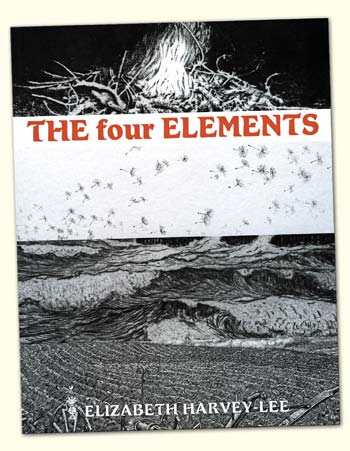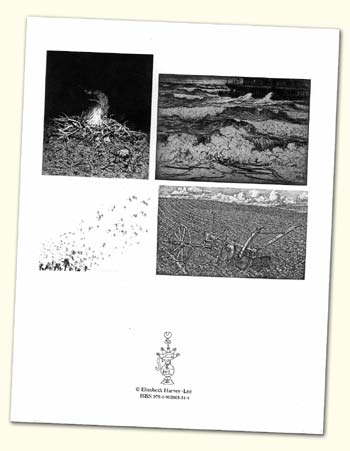|
THE FOUR ELEMENTS
 Classical
philosophy explained the terrestrial world in terms
of the Four Elements: Earth, Air, Fire and Water. Classical
philosophy explained the terrestrial world in terms
of the Four Elements: Earth, Air, Fire and Water.
In
Renaissance art these became motifs for artists.
In northern Europe particularly, publishers found
a ready market for sets of prints on this theme,
which lent itself to detailed depiction of nature
and daily life, as well as more emblematically to
personifications, signified by the appropriate attributes,
or portrayals as classical gods or goddesses with
suitable associations.
By
the eighteenth century the theme was largely decorative
and adapted to genre scenes and fêtes galantes with youths and maidens in appropriate activities, though Nattier painted four of Louis XV’s daughters, each as a personification of a different element.
Modern
prints, through their wide diversity of subject,
can be ‘made to fit’ the theme in the mind of this print dealer, though in the majority of cases completely unintentionally on the part of the artist.
Earth,
traditionally, can be represented as a woman with
several snakes, typical of goddesses of fertility;
or with the Cornucopia of Ceres, goddess of agriculture;
or the Scorpion of the Roman agricultural goddess
Tellus Mater; or wearing a turreted crown taken from
Cybele, ancient Phrygian Earth Mother.
Landscapes,
and their flora and fauna, in their own right naturally
suggest the earth, as well as specific activities
such as gathering fruit, digging, watering plants,
harvesting wheat, clamping potatoes etc.
Air was sacred to Juno in Antiquity, so can be presented
as the goddess with her attribute of the Peacock.
Also,
naturally, birds and other flying creatures were
traditionally used as symbols of the air; as sometimes
the chameleon, because according to Pliny chameleons
neither ate nor drank, but lived on air.
18th
century genre scenes might include children out of
doors playing with toy windmills, blowing bubbles
etc. and many more recent ‘pure’ landscape scenes
show wind-blown clouds, grass or trees and real windmills.
Fire,
can be personified by a woman with her hair enflamed,
or holding a thunderbolt; or with reference to the
legendary Phoenix rising from the ashes. In Hecke’s image of this element from his set of the Elements, Orpheus’ visit to the Underworld is unusual iconography for the theme. More conventionally it was Vulcan, blacksmith to the gods, forging Aeneas’ armour who figured.
By
extension in modern times the image of any smith,
especially when shoeing horses might signify. Domestic
firesides; garden bonfires; and accidental disasters
might complete the inventory.
 Water conventionally was shown as a River god with spilt
urn from which water flows, or as the sea god Neptune
and followers, Triton and Nereids, accompanied by
dolphins, and a variety of fish and sea creatures,
including hippocampi, half horse/half fish. Water conventionally was shown as a River god with spilt
urn from which water flows, or as the sea god Neptune
and followers, Triton and Nereids, accompanied by
dolphins, and a variety of fish and sea creatures,
including hippocampi, half horse/half fish.
In genre
scenes figures may be angling on a river bank or
from a boat, or play by fountains in a garden.
Any
marine landscape automatically fits the bill, as
any landscape with freshwater lakes, rivers, pond
or water in some other form.
Of
course, landscape artists of all periods have delighted
in expressing the ‘elemental’ qualities of wind and rain, as the beauty of Spring blossom and abundance of Summer harvests.
Published Summer 2014
44 pages, 117 items, 123 illustrations,
10 being in colour.
(U.K.
price: £12, International orders £16)
Prints
available
Prints from this catalogue are still
available and in due course will be featured within the Selections section
of the website.
^ Return to the top of this page ^
|
|
Artists
included in the catalogue:
- Acroyd N
- Anderson
S
- Baskett
C H
- Beatrizet
N
- Béjot E
- Blaker
M
- Blampied
E
- Bonington
R P
- Bracquemond
F
- Briscoe
A
- Burridge
F V
- Butcher
E
- Chahine
E
- David
H
- Delasalle
A
- Desborough
C I
- Detmold
C M & E J
- Dupont
P
- Fergusson
C J
- Ferrier
G S
- Fischer
O
- Frank
H
- Freeth
H A
- Fürstova M
- Gaillard
R
- Galle
T
- Goff
R
- Graf
O
- Gray
J
- Haig
A
- Hall
O
- Hamson
T D
- Hardie
M
- Hecke
A
(Hecken A van de /or Heckius)
- Heerschel
?
- Hirst
N
- Homan
R
- Howarth
A
- Hunnerstone
P
- Isabey
E
- Keene
C
- Komjàti J
- Laing
F
- Lalanne
M
- Larsson
C
- Legros
A
- Luyken
C
- Manning
W W
- Marples
G
- Mathiesen
J G
- McBey
J
- Michelangelo
- Millet
J F
- Mole
F
- Muyden
E
- van
Nattier J M
- Neumann
H
- Newton
E W
- Nooms
R
- Odescalchi
V
- Oppenheimer
J
- Passe
C
- de
Pennell J
- Pitfield
T B
- Pott
C
- Pryse
G S
- Rembrandt
- Renison
W
- Richmond
T K
- Robertson
P
- Robins
W P
- Robinson
J C
- Robinson
M C
- Roman
R
- Rosa
S
- Roussel
T
- Rowlandson
T
- Rushbury
H
- Schaufelein
H
- Segonzac
A D
- de
Seguin A
- Shakra
W A
- Shannon
C
- Smallfield
F
- Smart
D I
- Southall
J E
- Straet
J van
de
- Strang
I
- Strang
W
- Taylor
C W
- Unwin
F S
- Velde
J van
de (II)
- Vogeler
H
- Ward
L M
- Wicks
D V
- Wilson
E
- Wyllie
H
- Zeeman
Return to the top
|